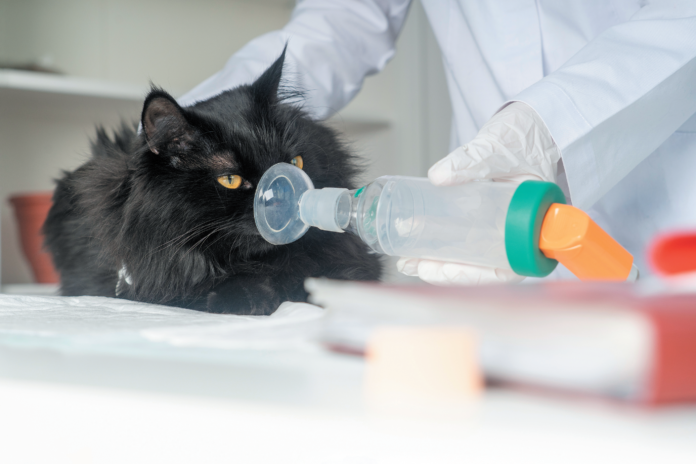We often think of cats as exacerbating breathing problems in people with asthma. But cats, too, can suffer from the wheezing and coughing that come with the disease, known in the veterinary world as “feline asthma” or “chronic bronchitis.” At least 1 percent of cats are affected, with estimates as high as 5 percent. Some believe the illness is becoming more common as a result of industrial pollutants. Exposure to second-hand smoke is another potential contributing factor.
One of the most common ways to treat the condition is with oral steroids in the form of tablets. However, says International Cat Care, treatment with an inhaler (or puffer, as it is commonly called) can be preferable because it delivers the medicine directly to the lungs and also comes with fewer side effects than the tablets.
The problem is that as difficult as it is to get some cats to take a pill, it can be even more difficult to get them to use an inhaler — a little mask that covers the mouth and nose and allows a pet to inhale the medication over a number of breaths. And the last thing you want to do with a cat who is having difficulty breathing is add to his stress or fear by trying to force something over his face.
That’s why International Cat Care, in partnership with Trudell Animal Health (makers of inhalers), has created a new series of six videos designed to help people acclimate their asthmatic cat to the breathing apparatus. Each video is 5 to 7 minutes in length. The best part about them is that they are excellent reminders in general that cat training always needs to go slowly and should be positive in nature, with the cat voluntarily participating rather than being forced into doing something he doesn’t want.
The first video is an overview, with the next five designed to take you through the specific steps, all of which are broken down. For instance, the first recommendation is to spread out the parts of the inhaler on the floor so your cat can simply examine them. To get your cat used to putting his nose inside a mask, it’s best to start with getting him to put his nose into small plant pots in return for treats and then proceed to narrower openings, like those in toilet paper rolls. From there the cat can “graduate” to putting his nose into the tighter fit of an inhaler.
Because the mask needs to fit snugly against the cat without air escaping, the videos recommend first putting the inhaler on parts of the cat’s body where he wouldn’t mind being attached to it, like his back. There are tips for accustoming a cat to the sounds the inhaler makes, too.
The videos make the point that if a cat doesn’t seem like he is in the mood to train, it’s better to step back and take a break than to try to keep going. Likewise, if a cat is having difficulty getting the hang of a particular step, it’s better to go one step backwards and have him succeed at the previous step and then try to move forward. That respectful approach assures the pet’s voluntary participation.
What the videos also point out is that different cats respond to different rewards. While some will take a piece of their usual kibble as a reward for getting something right, others will need a special treat that’s outside of the ordinary. And some cats, the videos say, would prefer being petted and stroked to receiving food for getting something right. You really need to go with your cat’s preferences.
The videos don’t say how long it will take to adjust a cat to using an inhaler, but that’s probably on purpose. Different cats are going to need different amounts of time to ramp up. It could conceivably take a couple of months. That’s okay. If it’s something you want your pet to feel comfortable with for the rest of his life, a couple of months isn’t much of a time investment to avoid a daily struggle and maintain the good bond you enjoy with your pet.
To have a look at the videos on Cat Care International’s site, visit icatcare.org/inhalertraining.





My Bubba, my kitty 11 years old sound like he has the croup. Healso coughs and sneezes at times. My Baby short hair kitty Casey snores and sounds like she has asthma.I would like some answers to these question. There was smoking in the home. Now we moved three years ago there is none. We quit.